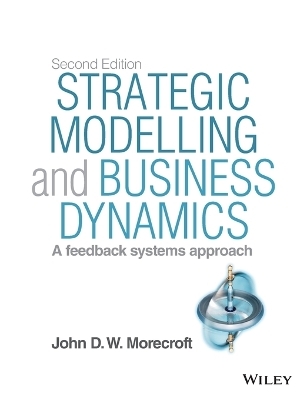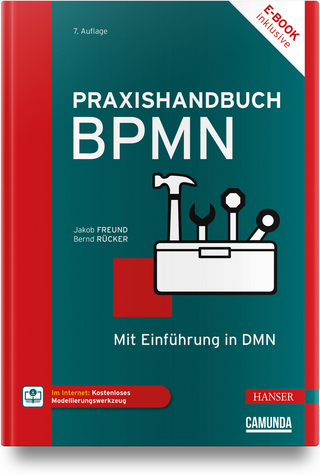
Strategic Modelling and Business Dynamics, + Website
John Wiley & Sons Inc (Verlag)
9781118844687 (ISBN)
Insightful modelling of dynamic systems for better business strategy
The business environment is constantly changing and organisations need the ability to rehearse alternative futures. By mimicking the interlocking operations of firms and industries, modelling serves as a ‘dry run’ for testing ideas, anticipating consequences, avoiding strategic pitfalls and improving future performance.
Strategic Modelling and Business Dynamics is an essential guide to credible models; helping you to understand modelling as a creative process for distilling and communicating those factors that drive business success and sustainability. Written by an internationally regarded authority, the book covers all stages of model building, from conceptual to analytical. The book demonstrates a range of in-depth practical examples that vividly illustrate important or puzzling dynamics in firm operations, strategy, public policy, and everyday life.
This updated new edition also offers a rich Learners' website with models, articles and videos, as well as a separate Instructors' website resource, with lecture slides and other course materials (see Related Websites/Extra section below). Together the book and websites deliver a powerful package of blended learning materials that:
Introduce the system dynamics approach of modelling strategic problems in business and society
Include industry examples and public sector applications with interactive simulators and contemporary visual modelling software
Provide the latest state-of-the-art thinking, concepts and techniques for systems modelling
The comprehensive Learners' website features models, microworlds, journal articles and videos. Easy-to-use simulators enable readers to experience dynamic complexity in business and society. Like would-be CEOs, readers can re-design operations and then re-simulate in the quest for well-coordinated strategy and better performance. The simulators include a baffling hotel shower, a start-up low-cost airline, an international radio broadcaster, a diversifying tyre maker, commercial fisheries and the global oil industry.
"Much more than an introduction, John Morecroft’s Strategic Modelling and Business Dynamics uses interactive ‘mini-simulators and microworlds’ to create an engaging and effective learning environment in which readers, whatever their background, can develop their intuition about complex dynamic systems."
John Sterman, Jay W. Forrester Professor of Management, MIT Sloan School of Management
"Illustrated by examples from everyday life, business and policy, John Morecroft expertly demonstrates how systems thinking aided by system dynamics can improve our understanding of the world around us."
Stewart Robinson, Associate Dean Research, President of the Operational Research Society, Professor of Management Science, School of Business and Economics, Loughborough University
John Morecroft is Senior Fellow in Management Science and Operations at London Business School where he has taught system dynamics, problem structuring and strategy in MBA, PhD and Executive Education programmes. He served as Associate Dean of the School's Executive MBA and co-designed EMBA-Global, a dual degree programme with New York's Columbia Business School.
About the Author xvii
Foreword by Peter Checkland xix
Preface to the Second Edition xxi
Preface from the First Edition xxv
How to Use This Book xxxv
Chapter 1 The Appeal and Power of Strategic Modelling 1
Introduction 1
A New Approach to Modelling 5
The Puzzling Dynamics of International Fisheries 7
Model of a Natural Fishery 10
Simulated Dynamics of a Natural Fishery 12
Operating a Simple Harvested Fishery 13
Harvesting in Bonavista, Newfoundland – A Thought Experiment 15
A Start on Analysing Dynamics and Performance Through Time 17
Saving Bonavista – Using Simulation to Devise a Sustainable Fishery 20
Dynamic Complexity and Performance Through Time 20
Cunning Fish – A Scenario with Reduced Dynamic Complexity 23
Preview of the Book and Topics Covered 25
Appendix – Archive Materials from World Dynamics 27
References 28
Chapter 2 Introduction to Feedback Systems Thinking 31
Ways of Interpreting Situations in Business and Society 31
Event-oriented Thinking 32
Feedback Systems Thinking – An Illustration 34
A Shift of Mind 37
The Invisibility of Feedback 38
A Start on Causal Loop Diagrams 39
Structure and Behaviour Through Time – Feedback Loops and the Dynamics of a Slow-to-Respond Shower 41
Processes in a Shower ‘System’ 44
Simulation of a Shower and the Dynamics of Balancing Loops 45
From Events to Dynamics and Feedback – Drug-related Crime 47
A Feedback View 48
Scope and Boundary of Factors in Drug-related Crime 50
An Aside – More Practice with Link Polarity and Loop Types 51
Purpose of Causal Loop Diagrams – A Summary 52
Feedback Structure and Dynamics of a Technology-based Growth Business 52
Causal Loop Diagrams – Basic Tips 55
Picking and Naming Variables 55
Meaning of Arrows and Link Polarity 56
Drawing, Identifying and Naming Feedback Loops 57
Causal Loop Diagram of Psychological Pressures and Unintended Haste in a Troubled Internet Start-Up 58
References 61
Chapter 3 Modelling Dynamic Systems 63
Asset Stock Accumulation 63
Accumulating a ‘Stock’ of Faculty at Greenfield University 65
Asset Stocks in a Real Organisation – BBC World Service 69
The Coordinating Network 70
Modelling Symbols in Use: A Closer Look at Drug-related Crime 72
Equation Formulations 75
Drug-related Crime 76
Funds Required to Satisfy Addiction 77
Street Price and Price Change 78
Allocation of Police 79
Experiments with the Model of Drug-related Crime 80
A Tour of the Model 80
Escalating Crime – The Base Case 82
Drilling Down to the Equations 84
Anomalous Behaviour Over Time and Model Boundary 86
Benefits of Model Building and Simulation 89
References 90
Chapter 4 World of Showers 91
Getting Started 91
Taking a Shower in World of Showers A 92
Taking a Shower in World of Showers B 95
Redesigning Your World of Showers 96
Reflections on the World of Showers 98
Metaphorical Shower Worlds in GlaxoSmithKline, IBM and Harley-Davidson 100
Inside World of Showers 102
A Tour of Formulations in the Comfort-seeking Loop of the Hidden Shower 102
Interdependence of Showers – Coupling Formulations 105
Simulations of World of Showers B 105
References 107
Chapter 5 Cyclical Dynamics and the Process of Model Building 109
An Overview of the Modelling Process 109
Dynamic Hypothesis and Fundamental Modes of Dynamic Behaviour 111
Team Model Building 112
Employment and Production Instability – Puzzling Performance Over Time 117
Dialogue About Production Control 120
Thought Experiment: A Surprise Demand Increase in an Ideal Factory 122
Equation Formulations and Computations in Production Control 124
Forecasting Shipments – Standard Formulations for Information Smoothing 126
Inventory Control – Standard Formulations for Asset Stock Adjustment 127
Desired Production 128
The Computations Behind Simulation 129
Modelling Workforce Management and Factory Production Dynamics 133
Dialogue About Workforce Management 133
Operating Constraint Linking Workforce to Production 135
Simulation of the Complete Model: A Surprise Demand Increase in a Factory Where Production is Constrained by the Size of the Workforce 136
Pause for Reflection 140
Equation Formulations in Workforce Management 140
Departure Rate – Standard Formulation for Stock Depletion 141
Hiring – Standard Formulations for Asset Stock Replacement and Adjustment 142
Workforce Planning 144
Chronic Cyclicality in Employment and Production and How to Cure It 145
The Curious Effect of Random Variations in Demand 145
Industry Cyclicality and Business Cycles 147
Policy Formulation and What-ifs to Improve Factory Performance 148
Modelling for Learning and Soft Systems 152
A Second Pause for Reflection: System Dynamics and Soft Systems 153
A Link to Soft Systems Methodology 156
Alternative Views of a Radio Broadcaster 159
Appendix 1: Model Communication and Policy Structure Diagrams 162
Appendix 2: The Dynamics of Information Smoothing 164
References 166
Chapter 6 The Dynamics of Growth from Diffusion 169
Stocks and Flows in New Product Adoption – A Conceptual Diffusion Model 171
The Bass Model – An Elegant Special Case of a Diffusion Model 172
The Dynamics of Product Adoption by Word-of-mouth 175
The Need to Kick-start Adoption 177
The Complete Bass Diffusion Model With Advertising 177
The Dynamics of Product Adoption by Word-of-mouth and Advertising 179
A Variation on the Diffusion Model: The Rise of Low-cost Air Travel in Europe 182
easyJet – A Bright Idea, but Will it Work? 182
Visualising the Business: Winning Customers in a New Segment 183
Visualising Retaliation and Rivalry 186
Feedback Loops in the easyJet Model 188
Strategy and Simulation of Growth Scenarios 189
Using the Fliers Simulator to Create Your Own Scenarios 193
Simulation, Predictions and Scenarios 194
Conclusion 194
Appendix: More About the Fliers Model 195
Back to the Future – From easyJet to People Express and Beyond 197
References 199
Chapter 7 Managing Business Growth 201
A Conceptual Model of Market Growth and Capital Investment 203
Background to the Case 203
Adopting a Feedback View 204
Formulation Guidelines for Portraying Feedback Structure 206
Review of Operating Policies and Information Flows in the Market Growth Model 209
Customer Ordering 209
Sales Force Expansion 210
Budgeting 211
Capital Investment 212
Goal Formation 214
An Information Feedback View of Management and Policy 215
Information Available to Decision Makers and Bounded Rationality 217
Nature of Decision Making and the Decision Process 220
Policy Structure and Formulations for Sales Growth 222
Sales Force Hiring – Standard Stock Adjustment Formulation 223
Sales Force Budgeting – Revenue Allocation and Information Smoothing 223
Order Fulfilment – Standard Stock Depletion Formulation 225
Customer Ordering 226
Policy Structure and Formulations for Limits to Sales Growth 226
Customer Response to Delivery Delay – Non-linear Graphical Converter 228
Customers’ Perception of Delivery Delay – Information Smoothing 229
Order Fulfilment and Capacity Utilisation 229
Policy Structure and Formulations for Capital Investment 231
Assessment of Delivery Delay 232
Goal Formation – Weighted Average of Adaptive and Static Goals 232
Capacity Expansion – Fractional Asset Stock Adjustment 233
Production Capacity – Two-Stage Stock Accumulation 236
Simulation Experiments 237
Simulation of Sales Growth Loop 238
Strength of Reinforcing Loop 241
Simulation of Sales Growth and Customer Response Loops 242
Simulation of the Complete Model with all Three Loops Active – The Base Case 246
Redesign of the Investment Policy 250
Top Management Optimism in Capital Investment 251
High and Unyielding Standards – A Fixed Operating Goal for Delivery Delay 253
Policy Design, Growth and Dynamic Complexity 256
Conclusion 257
Overview of Policy Structure 257
Growth and Underinvestment at People Express? 261
More Examples of Growth Strategies that Failed or Faltered – and One that Succeeded 262
Growth Strategy for New Products and Services in a Competitive Industry 264
Appendix – Gain of a Reinforcing Loop 266
References 268
Chapter 8 Industry Dynamics – Oil Price and the Global Oil Producers 271
Problem Articulation – Puzzling Dynamics of Oil Price 272
Towards a Dynamic Hypothesis 274
Model Development Process 275
A Closer Look at the Stakeholders and Their Investment Decision Making 278
Investment by the Independent Producers 279
Development Costs 280
Policy Structure and Formulations for Upstream Investment – Fractional Asset Stock Adjustment 282
Oil Price and Demand 284
The Swing Producer 286
Quota Setting 288
The Opportunists 290
The Rise of Russian Oil – Incorporating Unforeseen Political Change 291
The Shale Gale – Incorporating Unforeseen Technological Change 292
Connecting the Pieces – A Feedback Systems View 294
Two Invisible Hands and More 295
The Visible Hand of OPEC 297
Webs of Intrigue – Inside OPEC’s Opulent Bargaining Rooms 297
A Simple Thought Experiment: Green Mindset and Global Recession 300
Using the Model to Generate Scenarios 301
Archive Scenario 1: 10-Year Supply Squeeze Followed by SupplyGlut 301
Archive Scenario 2: Quota Busting in a Green World 306
Scenario from the Mid-1990s to 2020: Asian Boom with Quota Busting, Cautious Upstream Investment and Russian Oil 309
A High Price Scenario from the Mid-1990s to 2020: How to PushOil Price Over $60 per Barrel 314
A 2010–2034 Scenario: Subdued Global Oil Economy with Shale Gale and OPEC Supply Boost 317
Modified 2010–2034 Scenario: Subdued Global Oil Economy with Shale Gale and Punitive Saudi Supply Control 322
2010–2034 Thought Experiment: Subdued Global Oil Economy with a Shale Gale and Mooted US Supply Control – The ‘Saudi America’ Hypothesis 324
Devising New Scenarios 327
Effect of Global Economy and Environment on Demand 327
Cartel Quota Bias 327
Opportunists’ Capacity Bias 328
Oil Price Bias 328
Capex Optimism 328
Time to Build Trust in Russia (in Oil World 1995 and 2010) 329
Endnote: A Brief History of the Oil Producers’ Project 329
References 331
Chapter 9 Public Sector Applications of Strategic Modelling 333
Urban Dynamics – Growth and Stagnation in Cities 334
Urban Model Conceptualisation 335
Medical Workforce Dynamics and Patient Care 340
Background 341
Medical Workforce Planning Model 342
Quality of Patient Care 346
Base Run – Changing Composition of the Medical Workforce 348
Base Run – Quality of Patient Care 350
Intangible Effects of the European Working Time Directive 351
Modelling Junior Doctor Morale 351
Overview of the Complete Model 353
The Formulation of Work–Life Balance and Flexibility 354
Simulations of the Complete Model 355
Conclusions from the Medical Workforce Study 359
Fishery Dynamics and Regulatory Policy 361
Fisheries Management 361
A Simple Harvested Fishery – Balancing Catch and Fish Regeneration 363
A Harvested Fishery with Endogenous Investment – Coping with a Tipping Point 366
Simulated Dynamics of a Harvested Fishery with Endogenous Investment 369
Control and Regulation – Policy Design for Sustainable Fisheries 371
Formulation of Deployment Policy 373
Stock and Flow Equations for Ships at Sea, Ships in Harbour and Scrap Rate 375
Simulated Dynamics of a Regulated Fishery – The Base Case 375
Policy Design – A Higher Benchmark for Fish Density 379
Dynamics of a Weakly Regulated Fishery 381
Policy Design – Lower Exit Barriers Through Quicker Scrapping of Idle Ships 383
Sustainability, Regulation and Self-Restraint 387
Conclusion 387
Appendix – Alternative Simulation Approaches 388
From Urban Dynamics to SimCity 389
Discrete-event Simulation and System Dynamics 390
Conclusions on Alternative Approaches to Simulation Modelling 396
References 398
Chapter 10 Model Validity, Mental Models and Learning 403
Mental Models, Transitional Objects and Formal Models 404
Models of Business and Social Systems 406
Tests for Building Confidence in Models 407
Model Confidence Building Tests in Action: A Case Study in Fast-moving Consumer Goods 410
Soap Market Overview 410
The Modelling Project 411
Model Structure Tests and the Soap Industry Model 412
Boundary Adequacy and Structure Verification Tests Applied to a Simple Soap Model 413
A Refined View of the Market 416
Boundary Adequacy and Sector Map of the Complete Soap Industry Model 417
Managerial Decision-making Processes in the Old English Bar Soap Company 419
Managerial Decision-making Processes in Global Personal Care 420
Managerial Decision-making Processes in Supermarkets 421
Equation Formulation Tests and the Soap Industry Model 422
Substitution of Bar Soap by Shower Gel 423
Brand Switching Between Competing Bar Soap Products 424
Model Behaviour Tests and Fit to Data 428
Tests of Fit on Simulations of the Soap Industry Model – The Base Case 432
Tests of Learning from Simulation 436
Comparing Simulations with Expectations and Interpreting Surprise Behaviour 436
Partial Model Simulations to Examine Pet Theories and Misconceptions 437
Family Member Tests 438
Policy Implication Tests 439
Understanding Competitive Dynamics in Fast-moving Consumer Goods 439
Summary of Confidence Building Tests 441
Conclusion – Model Fidelity and Usefulness 444
Endnote: The Loops of Feedback 447
References 449
About the Website Resources 451
Index 452
| Erscheint lt. Verlag | 26.6.2015 |
|---|---|
| Verlagsort | New York |
| Sprache | englisch |
| Maße | 185 x 246 mm |
| Gewicht | 975 g |
| Themenwelt | Mathematik / Informatik ► Mathematik ► Finanz- / Wirtschaftsmathematik |
| Wirtschaft ► Betriebswirtschaft / Management ► Unternehmensführung / Management | |
| ISBN-13 | 9781118844687 / 9781118844687 |
| Zustand | Neuware |
| Informationen gemäß Produktsicherheitsverordnung (GPSR) | |
| Haben Sie eine Frage zum Produkt? |
aus dem Bereich


